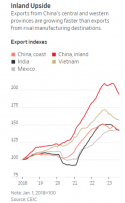Proposition (from a guest on the Hidden Forces podcast): China's apparent reduction in UST holdings is accounted for/offset by:
- Mark to market of holdings at reduced UST prices;
- Agency bond holdings increasing (additional $100bn in 2022);
- USTs being held through non-US custodians in e.g. HK, Cayman, Lux, etc. and so not showing as PRC-owned.

